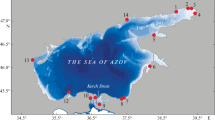Abstract
Global ocean tides data were derived from Geosat altimeter data by means of the Quasi-Harmonic Constituent Method (QHCM). Tidal solutions with resolution of 1°/3 in longitude and latitude were obtained for constituentsM 2,S 2,O 1,K 1,M 4 andMS 4. The means sea heights above the reference ellipsoid were also obtained consequently. The obtained tidal constants were compared with those from deepsea and island tide gauge data. The rms differences between the harmonic constants derived from Geosat altimetry and deep-sea tide gauges forM 2,S 2,O 1 andK 1 ranged from 1.4 cm to 2.6 cm, although the GM altimeter data have significant errors due to instrument malfunction and other reasons.M 2 tide obtained was the most accurate one among all the tides. Comparison also showed that island tidal constants cannot represent well the tidal distribution in the ocean near the island, because of the significant local effect on tides.
Similar content being viewed by others
References
Cartwright D. E. Ray R. D., 1990. Oceanic Tides from Geosat Altimetry.J. Geophys. Res. 95: 3069–3090.
Cartwright D. E., Ray R. D., 1991. Energetics of Global Ocean Tides from Geosat Altimetry.J. Geophys. Res. 96: 16897–16921.
Fang G., 1974. Quasi-Harmonic Constituent Method for Analysis and Prediction of Tides, I. Quasi-Harmonic Constituent.Studia Marina Sinica 9: 1–15.
Fang G., 1976. Quasi-Harmonic Constituent Method for Analysis and Prediction of Tides, II. Analysis of Short Period Observations.Studia Marina Sinica 11: 33–56.
Fang G., 1981. Quasi-Harmonic Constituent Method for Analysis and Prediction of Tides, III. A Practical Procedure for Analyzing Tidal Streams and Tidal Elevations.Studia Marina Sinica 18: 19–40.
Ma X. C., Shum C. K., Eanes R. J. et al., 1994. Determination of Ocean Tides from the First Year of TOPEX/POSEIDON Altimeter Measurements.J. Geophys Res 99: 24809–24820.
Matsumoto K., Ooe M., Sato T. et al. 1995. Ocean Tide model obtained from TOPEX/POSEIDON Altimetry Data.J. Geophys. Res 100: 25319–25330.
Schrama E. J. O., Ray R. D., 1994. A Preliminary Tidal Analysis of TOPEX/POSEIDON Altimetry.J. Geophys. Res. 99: 24799–24808.
Schwiderski E. W., 1980a. On Charting Global Ocean Tides.Rev. Geophys. 18: 243–268.
Schwiderski E. W., 1980b. Ocean Tides, I. Global Ocean Tidal Equations.Mar. Geod. 3: 161–217.
Schwiderski E. W., 1980c. Ocean Tides, II. A Hydrodynamical Interpolation Model.Mar. Geod. 3: 219–255.
Tapley B. D., Watkins M. M., Ries J. C. et al., 1996. The JGM-3 Gravity Model.J. Geophys. Res. 101: 28029–28049.
Author information
Authors and Affiliations
Additional information
Contribution No. 3714 from the Institute of Oceanology, Chinese Academy of Sciences.
The present work was supported by the National Climbing Program “Asian—Pacific Space Geodynamics” and National 863 Program under Grant 818-06-1, and was partially supported by Daewoo Corporation, Korea for the second author.
Rights and permissions
About this article
Cite this article
Yue, F., Byung Ho, C. & Guo-hong, F. Global ocean tides from Geosat altimetry by Quasi-Harmonic analysis. Chin. J. Ocean. Limnol. 18, 193–198 (2000). https://doi.org/10.1007/BF02842663
Received:
Accepted:
Issue Date:
DOI: https://doi.org/10.1007/BF02842663




